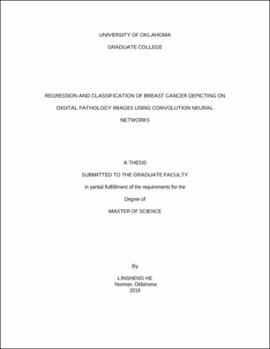| dc.contributor.advisor | Zheng, Bin | |
| dc.contributor.author | He, Linsheng | |
| dc.date.accessioned | 2019-05-07T14:30:21Z | |
| dc.date.available | 2019-05-07T14:30:21Z | |
| dc.date.issued | 2019-05-10 | |
| dc.identifier.uri | https://hdl.handle.net/11244/319572 | |
| dc.description.abstract | Computer-Aided Detection and Diagnosis (CAD) of medical images has been developed and tested for the last three decades. It is designed to be an effective time-saving assistant and provide doctors with a wealth of diagnostic information in clinical practice. Traditional CAD techniques utilize the features of manual extraction of images and algorithms that use shallow supervised learning. They have great limitations in medical image classification, effective feature extraction, and segmentation. In order to overcome these limitations, deep learning has emerged as a promising technology in CAD development. In this study, my motivation is to investigate an optimal approach of applying Convolutional Neural Network (CNN), one of the deep learning models, to assist detection of residual breast cancer using histopathology images after Neoadjuvant treatment (NAT). In this process, CNN models were implemented and compared using different optimization objectives and evaluation metrics.
Specifically, the CAD system used two CNN schemes, namely, ResNet and SE-ResNeXt. To detect the residual cancer cells from the pathology images after NAT, a regression CAD system was developed to predict cancer cellularity value followed by applying a concordance evaluation metric to compare and verify the effectiveness of the model. The performance of integrated models for predicting cancer cellularity and providing doctors with second information is almost the same as the performance of the supplementary information given by other doctors.
To distinguish classes of cancer cellularity in the pathology images, a classification CAD system was developed to predict the probability of classes. The classier performance was evaluated using the Receiver Operating Characteristic (ROC) method. When using a 5-fold cross-validation method to classify the classes of pathology images, the best area under the ROC curve was 0.905±0.075. The results of study indicated that CNN based deep learning is a promising CAD technology, which can significantly improve the diagnostic efficacy of detecting residual breast cancer cells in pathology images after NAT with high performance. | en_US |
| dc.language | en_US | en_US |
| dc.rights | Attribution-NoDerivatives 4.0 International | * |
| dc.rights.uri | https://creativecommons.org/licenses/by-nd/4.0/ | * |
| dc.subject | Medical Imaging Processing | en_US |
| dc.subject | Convolutional Neural Network | en_US |
| dc.subject | Computer-Aided Diagnosis | en_US |
| dc.subject | Engineering, Electronics and Electrical. | en_US |
| dc.title | Regression and Classification of Breast Cancer Depicting on Digital Pathology Images Using Convolution Neural Networks | en_US |
| dc.contributor.committeeMember | Liu, Hong | |
| dc.contributor.committeeMember | Xiang, Liangzhong | |
| dc.date.manuscript | 2019-05 | |
| dc.thesis.degree | Master of Science | en_US |
| ou.group | Gallogly College of Engineering::School of Electrical and Computer Engineering | en_US |

